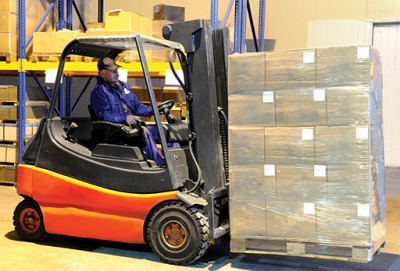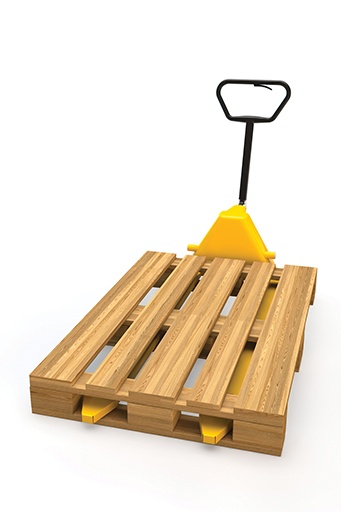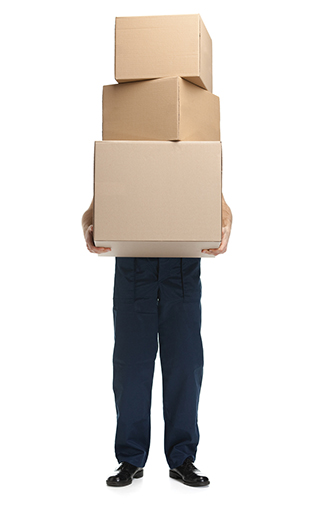Safe lifting in production environments
by all | 28 September 2013 8:30 am
 [1]
[1]Photos ©BigStockPhoto.com
By Peter Saunders
While the sign industry has seen automation significantly reduce manual labour in wide- to super-wide format print production environments, there are still many employees working in these spaces who bear a heavy burden each day—often literally, as they must move ever-larger quantities of both printing consumables and final printed output around.
As the Specialty Graphic Imaging Association (SGIA) has pointed out, these situations can raise safety issues. Heavy lifting can lead to serious back injuries and worker compensation claims.
“Nobody likes to think of him or herself as weak and unable to handle a seemingly simple lifting task,” says Marci Kinter, SGIA’s vice-president (VP) of government and business information, “but the truth is our bodies wear down over time and require more rest, conditioning and nourishment. A physical injury early in life can limit you for a day or two, but an injury later in life can effectively end your career altogether.”
Of course, the young are far from immune. According to the American Society of Safety Engineers (ASSE), the most frequent injury resulting in lost work time for employees under 18 years old in the U.S. is overexertion from lifting heavy objects.
Being mindful
One of the risks from unsafe lifting is a hernia, where muscles rupture and part of the body’s internal system protrudes. Surgery is often necessary for this condition.
Other injuries can affect the arms, neck and shoulders. Like back injuries, they are usually caused by improper lifting after inadequate training or while working in cramped conditions.
It is rare for a single incident to cause a back injury. Rather, the repetition of improper motions is usually to blame.
So, to help prevent back injuries, it is important to make sure employees receive proper training to carry out lifting tasks easily and safely within the sign shop, production room or other printing facility.
 [2]
[2]As they grow, some wide-format printing facilities need forklifts to move pallets of substrates around.
“Be mindful of employees carrying objects long distances,” says Kinter. “Teach them to avoid lifting from floor level or above shoulder height, especially heavy loads. Give new employees, in particular, more information about the range of tasks they are likely to face.”
In some cases, for example, an employee working alone needs to seek out help to lift an object, rather than attempt to lift it on his/her own. It is important for these employees to know there is no shame in asking for assistance. One approach is for employers to specify a maximum weight limit for any single lift.
Factors that contribute to back injuries include the frequency, duration and type of lifting. With this in mind, employees must learn to recognize situations where their back is most at risk. It is also important for them to take time and stretch their muscles before starting any strenuous work. And if they will be doing a lot of heavy or repetitive lifting, they should work at a reduced pace to allow recovery time between stresses.
There are also situations within a wide-format printing facility where employees will be working in an awkward position for a prolonged period. To avoid stiffness and soreness, they should take one-minute stretch breaks every so often.
Employees who have to lift should be in good physical condition beforehand. Strengthening their stomach muscles, maintaining a healthy weight and increasing their flexibility will in turn improve their ability to lift.
 [3]
[3]A pallet truck is another handy way of moving heavy loads around without manual lifting.
Tools for the job
Employers, meanwhile, may need to invest in additional moving equipment, such as a dolly, or other assistive devices. Further automation of processes might involve a conveyer, a pallet truck, an electric or hand-powered hoist or a forklift, such as for pallets of printable substrates.
Heavy loads on a hand truck should be secured with straps. These attach to the back of the hand truck and wrap around the load to prevent it from falling off, particularly when being lifted to a greater height or up a flight of stairs.
‘Team straps’ wrap around the bodies of two or more people, in a crisscross fashion along their backs, and then are secured to the shared load. They reduce the risk of a back injury when bending down to pick up a heavy load.
Back-support belts strap around the waist. Some also include crisscrossed suspenders that strap over the shoulders. When tightened to fit the employee’s waist, the belt will brace the abdominals and support the spine.
“Employees have a responsibility to follow their training and obey the rules for lifting their supervisors and managers have established,” says Kinter. “This means using safety equipment the way it is intended. They should also co-operate with their employers by informing them of any hazardous handling activities.”
This communication can help determine, for example, if there are any obstructions to free movement that need to be removed or any slippery floors to cover within the wide-format printing facility. Carrying can be limited between hot and cold zones that put additional strain on employees’ bodies, as well as along paths that involve stairs or steep ramps. Lighting may also need to be improved for better visibility.
The key is to always be on the lookout for instances where employees have difficulty performing their daily tasks. Any excessive sweating, puffing, fatigue, poor posture and awkward movements are signs of safety issues. Statistics show one-third of back injuries on the job could have been prevented through better job design.
 [4]
[4]Even if a load isn’t too heavy for one person to carry, it is unwieldy if that person cannot see where he/she is walking.
10 steps to the perfect lift
SGIA recommends the following 10 steps to ensure the perfect lift:
- Plan ahead. Know what you are doing and where you are going and clear a path beforehand. This will help prevent you from making awkward motions when carrying a heavy load.
- Wear support. A belt designed to support your back will help you maintain a good lifting posture. Keep in mind, however, it will not enable you to lift a heavier weight!
- Balance your stance. A solid base of support is important, with feet shoulder width apart. Holding your feet too close together will cause instability, while holding them too far apart will hinder movement. It is okay to place one foot behind the load and the other next to it. Prepare to take short steps to maintain balance.
- Squat down. Standing on the balls of your feet (not the heels), get as close as possible to the load. Bend your knees and focus on keeping your spine straight. It can be useful to practise this lifting motion beforehand.
- Use your palms. Don’t just use your fingers to grip. Your palms will help ensure your grip will hold and not have to be switched while moving the load. Your grip will be stronger and more stable if you hold the load close to your body, rather than at the edge of your reach.
- Keep your posture. Tightening your abdominal muscles will keep your back in a good lifting position. Looking slightly upwards will also help maintain the proper spine position.
- Lift slowly and steadily. Use your legs and your abdominal and gluteal muscles to lift the load slowly, with no jerking movement. Your legs are many times stronger than your back muscles.
- Get help. As mentioned, if you are straining, the load is too heavy or the object is an awkward shape, get someone else to help you out. Before lifting the load with another person, make sure both of you have agreed on a path.
- Turn, don’t twist. When you need to change direction, point your feet where you want to go, then turn your whole body. Do not twist while you are carrying the load; always face the direction in which you are walking. If you need to turn, stop first, turn with small steps, then continue walking.
- Reverse the rules. When lowering a load and placing an object down, simply follow the same guidelines, but in the reverse order. If the load is not yet at its final destination, try to place it where there will be easy access for the next person.
With files from SGIA. For more information, visit www.sgia.org[5].
- [Image]: http://www.signmedia.ca/wp-content/uploads/2014/01/bigstock-Man-Lifting93AFDB.jpg
- [Image]: http://www.signmedia.ca/wp-content/uploads/2014/01/bigstock-Worker-And-93AFD5.jpg
- [Image]: http://www.signmedia.ca/wp-content/uploads/2014/01/bigstock-Yellow-hand93AFCB.jpg
- [Image]: http://www.signmedia.ca/wp-content/uploads/2014/01/bigstock-Workman-del93AFC8.jpg
- www.sgia.org: http://www.sgia.org
Source URL: https://www.signmedia.ca/safe-lifting-in-production-environments/